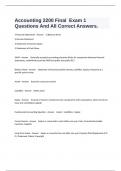Exam (elaborations)
Accounting 2200 Final Exam 1 Questions And All Correct Answers.
- Course
- Accounting
- Institution
- Accounting
4 Financial Statements - Answer 1) Balance Sheet 2) Income Statement 3) Statement of Owners Equity 4) Statement of Cash Flows GAAP - Answer Generally accepted accounting principles (Rules for comparison between financial statements, established by private FASB and public the public SEC)...
[Show more]



